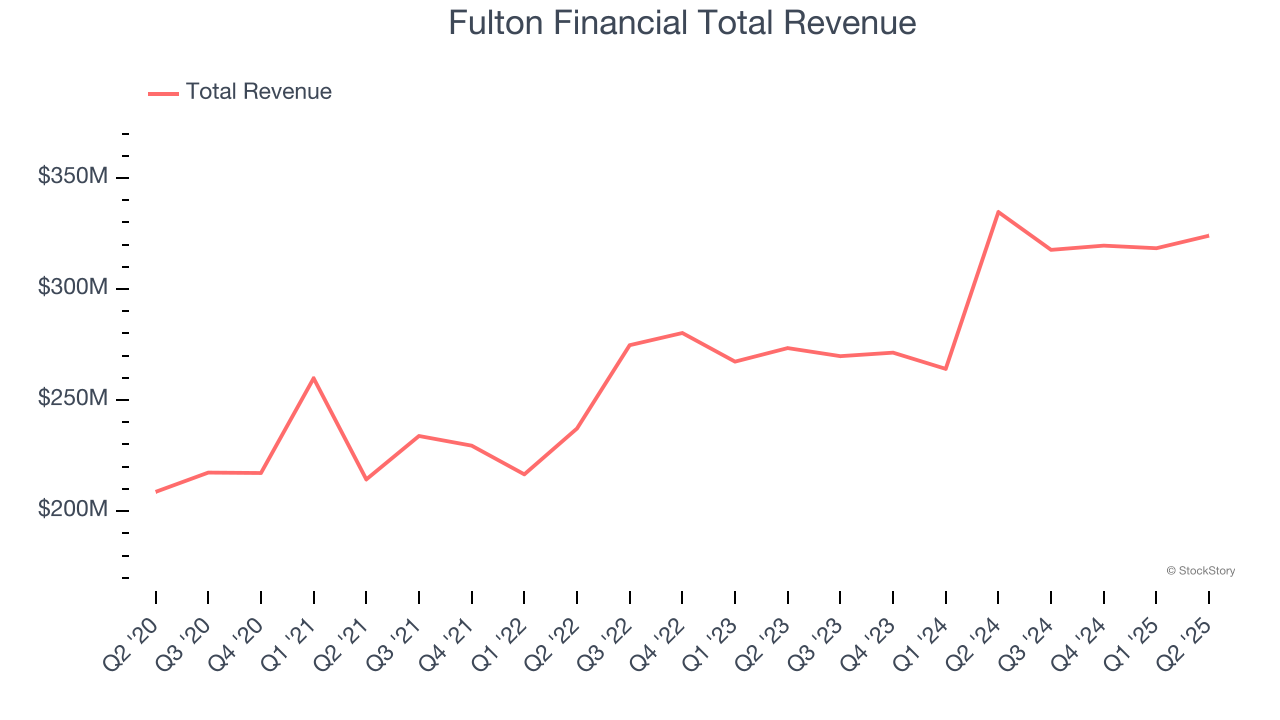|
|
|

|
|||||

|
|

As the Q2 earnings season wraps, let’s dig into this quarter’s best and worst performers in the regional banks industry, including Fulton Financial (NASDAQ:FULT) and its peers.
Regional banks, financial institutions operating within specific geographic areas, serve as intermediaries between local depositors and borrowers. They benefit from rising interest rates that improve net interest margins (the difference between loan yields and deposit costs), digital transformation reducing operational expenses, and local economic growth driving loan demand. However, these banks face headwinds from fintech competition, deposit outflows to higher-yielding alternatives, credit deterioration (increasing loan defaults) during economic slowdowns, and regulatory compliance costs. Recent concerns about regional bank stability following high-profile failures and significant commercial real estate exposure present additional challenges.
The 98 regional banks stocks we track reported a satisfactory Q2. As a group, revenues were in line with analysts’ consensus estimates.
While some regional banks stocks have fared somewhat better than others, they have collectively declined. On average, share prices are down 1.8% since the latest earnings results.
Tracing its roots back to 1882 in the heart of Pennsylvania, Fulton Financial (NASDAQ:FULT) is a financial holding company that provides banking, lending, and wealth management services to consumers and businesses across five Mid-Atlantic states.
Fulton Financial reported revenues of $324.1 million, down 3.2% year on year. This print exceeded analysts’ expectations by 1.9%. Overall, it was a very strong quarter for the company with a beat of analysts’ EPS estimates and a narrow beat of analysts’ tangible book value per share estimates.
"I'm proud that our team has delivered a new company record, with operating net income of $100.6 million, or $0.55 per diluted share, this past quarter," said Curt Myers, Chairman and CEO of Fulton.

Unsurprisingly, the stock is down 3.8% since reporting and currently trades at $18.32.
Is now the time to buy Fulton Financial? Access our full analysis of the earnings results here, it’s free.
With roots dating back to 1913 and a name derived from "United Missouri Bank," UMB Financial (NASDAQ:UMBF) is a financial holding company that provides banking, asset management, and fund services to commercial, institutional, and individual customers.
UMB Financial reported revenues of $689.2 million, up 76.7% year on year, outperforming analysts’ expectations by 8.6%. The business had a stunning quarter with a beat of analysts’ EPS and tangible book value per share estimates.

The market seems content with the results as the stock is up 4.9% since reporting. It currently trades at $115.08.
Is now the time to buy UMB Financial? Access our full analysis of the earnings results here, it’s free.
Pioneering the intersection of traditional banking and financial technology in the Pacific Northwest, Coastal Financial (NASDAQ:CCB) operates as a bank holding company that provides traditional banking services and Banking-as-a-Service (BaaS) solutions to consumers and businesses.
Coastal Financial reported revenues of $119.4 million, down 11.7% year on year, falling short of analysts’ expectations by 21.5%. It was a disappointing quarter as it posted a significant miss of analysts’ net interest income estimates and a significant miss of analysts’ EPS estimates.
Interestingly, the stock is up 4.5% since the results and currently trades at $106.
Read our full analysis of Coastal Financial’s results here.
With roots dating back to 1903 and a presence across Arkansas, Kansas, Missouri, Oklahoma, Tennessee, and Texas, Simmons First National (NASDAQ:SFNC) is a regional bank holding company that provides banking and financial services to individuals and businesses.
Simmons First National reported revenues of $220.6 million, up 8.3% year on year. This result surpassed analysts’ expectations by 1.6%. It was a strong quarter as it also produced a beat of analysts’ EPS estimates and a narrow beat of analysts’ net interest income estimates.
The stock is flat since reporting and currently trades at $19.83.
Read our full, actionable report on Simmons First National here, it’s free.
Founded in 1903 and rebranded from Bank of the Ozarks in 2018, Bank OZK (NASDAQ:OZK) is a commercial bank that specializes in real estate lending while offering a full range of banking services to individuals and businesses.
Bank OZK reported revenues of $392.8 million, up 6.8% year on year. This print missed analysts’ expectations by 7.2%. Overall, it was a slower quarter as it also logged a narrow beat of analysts’ EPS estimates and tangible book value per share in line with analysts’ estimates.
The stock is down 5.3% since reporting and currently trades at $49.32.
Read our full, actionable report on Bank OZK here, it’s free.
As a result of the Fed’s rate hikes in 2022 and 2023, inflation has come down from frothy levels post-pandemic. The general rise in the price of goods and services is trending towards the Fed’s 2% goal as of late, which is good news. The higher rates that fought inflation also didn't slow economic activity enough to catalyze a recession. So far, soft landing. This, combined with recent rate cuts (half a percent in September 2024 and a quarter percent in November 2024) have led to strong stock market performance in 2024. The icing on the cake for 2024 returns was Donald Trump’s victory in the U.S. Presidential Election in early November, sending major indices to all-time highs in the week following the election. Still, debates around the health of the economy and the impact of potential tariffs and corporate tax cuts remain, leaving much uncertainty around 2025.
Want to invest in winners with rock-solid fundamentals? Check out our Top 5 Growth Stocks and add them to your watchlist. These companies are poised for growth regardless of the political or macroeconomic climate.
StockStory is growing and hiring equity analyst and marketing roles. Are you a 0 to 1 builder passionate about the markets and AI? See the open roles here.
| Dec-10 | |
| Dec-03 | |
| Dec-02 | |
| Dec-02 | |
| Dec-02 | |
| Nov-25 | |
| Nov-25 | |
| Nov-24 | |
| Nov-17 | |
| Nov-12 | |
| Oct-28 | |
| Oct-27 | |
| Oct-23 | |
| Oct-22 | |
| Oct-21 |
Join thousands of traders who make more informed decisions with our premium features. Real-time quotes, advanced visualizations, backtesting, and much more.
Learn more about FINVIZ*Elite